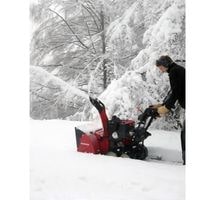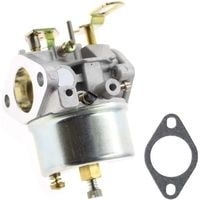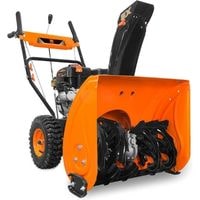Snowblower Leaking Gas. When your snowblower is leaking fuel, check the bottom of the bowl gasket and carburetor gasket. If they are missing or dry, this is causing gas leakage.
Change these old parts as soon as possible if you’ve had your snowblower for some years and they have not been changed yet.
If you see that both of them are intact but it’s still leaking then check the connections of the plastic housing that contains the filter. If this is cracked, it must be replaced with new parts.
Snowblower Leaking Gas

Carburetor gaskets can sometimes be the culprit for gas leaks but you can check this by removing and cleaning or replacing the gasket.
If the leak is coming from underneath at the carburetor and it was not an issue with the carburetor’s fuel lines or connections, then you likely have an issue with your carburetor itself.
If any of these parts have become damaged, consider purchasing new snowblower replacement parts.
We will discuss some problems with a snowblower when it starts leaking gas.
Fuel Pump Malfunction
To check whether the snowblower engine is leaking fuel, find the fuel pump and be certain that the fuel lines and pulse line fit tightly on the fuel pump.
Check for cracks in lines as well as pinholes in the pulse line’s gasket that are smooth-grained and free of nicks and abrasions. Also, make sure that the engine pump has plenty of gas oil mix in it.
Fuel Filter Problem
If you notice an excessive leak of gas from the snowblower, check to see if the connections to the fuel filter and filter housing are secure.
If there is a crack in either one, do not try to repair them because it will only lead to cracks growing in other areas as well.
Instead, completely replace the fuel filter and fuel line, and be sure to wipe up any gas spills when finished. Also, inspect the area and make sure that none of the lines have cracks or defects in all areas that are still good.
Carburetor Issue

Carburetors may become clogged with dirt, debris, and particles from the fuel itself.
Over time this will impact the efficiency it operates at, and eventually, the carburetor may become clogged to the point of no return.
When clogging occurs a snowblower performance and fuel efficiency drop rapidly.
If there is evidence of a buildup in the carburetor that is hard to remove.
This has reached such a point it is recommended that one cleans their carburetor using specialized products designed to clean carburetors properly and effectively.
Shut-off Solenoid For Fuel
Check the fuel shut-off valve for cracks or tiny holes, and ensure that the fuel lines fit tightly on the valve.
If the fuel shut-off solenoid is leaking, replace it. In addition, make sure you check the fuel shut-off lines for cracks or tiny holes. If a fuel shut-off line is leaking, replace it.
Faulty Prime Bulb
There is a possibility that the primer bulb is leaking gas. During the course of time, the rubber of the primer bulb can become brittle and cracked, causing the bulb to leak gas.
There are some instances in which a primer bulb leaks, so it is a good idea to replace the old one with a new one. It is very important not to try to patch or repair the primed bulb as doing so may result in leaks.
FAQs
A snowblower can be overprimed?
Fuel must be fed through the fuel lines and into the carburetor in order to prime the engine. The Toro snowblower recommends that you press the primer button twice and be careful not to over prime the engine, as it can flood the engine.
Is it possible for a primer bulb to flood an engine?
Poor mower handling can also cause flooding. Pulling the starter cord too hard or too many times with a stiff and jerky motion when trying to start up may make the engine turn over, causing flooding in your engine, so it’s always important to use proper operating techniques when starting up to prevent this.
Snowblower Leaking Gas
Related Guides
